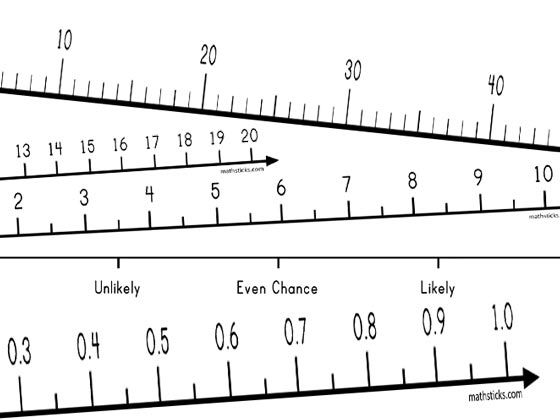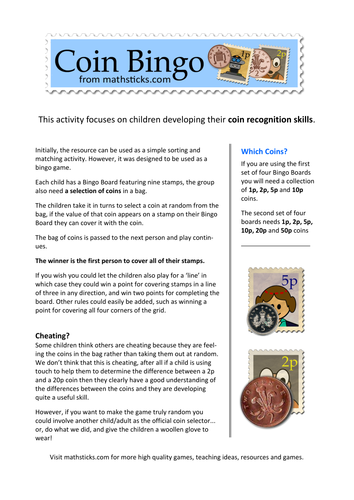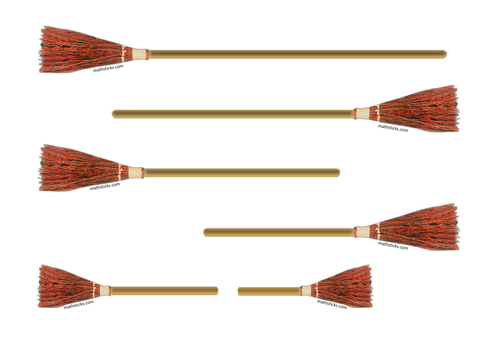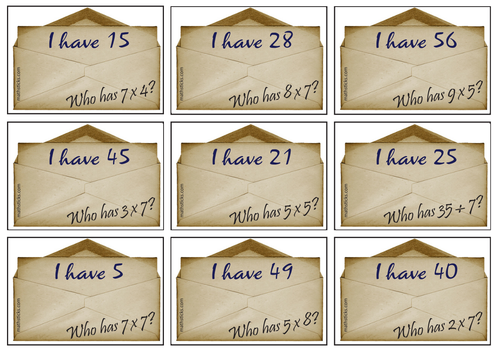
44Uploads
227k+Views
69k+Downloads
Math

Roman Number Bingo
A set of 20 Bingo Boards featuring Roman Numerals together with calling cards.
A fun way to help children reinforce how Roman Numerals are written.
Great group activity, or can be used with whole class. If you find this useful please comment.

Black Master Number Lines
A collection of 8 Mini desk-sized number lines useful for KS1 and KS2. These are simple, plain number lines suitable for one-to-one work or demonstrations. The set includes five of each of the following: 0-10, 1-10, 1-10 with halves, 0-20, 1-20, 0-100, and -10 to +10 in both horizontal and vertical format. See mathsticks.com for images. They have been very popular in many classrooms, particularly the -10 to +10 ones. Please rate and comment. Thanks.

George's Mathematical Medicine
The Mathematics Medicine booklet consists of 8 pages of maths problems suitable for Year 3 children.
The booklet uses the idea of a weird ‘medicine’ recipe from Roald Dahl’s George’s Marvellous Medicine.
In this maths resource, George’s teacher has designed his own weird medicine and the ingredients are all hidden inside this book of problems.
The children are presented with a series of problems and puzzles, each of which is based on a calculation skill linked to the National Curriculum.
As they solve the problems they will reveal the strange ingredient’s in their teachers recipe.
Have fun.
Note - this works best when printed as an A5 (folding) booklet - there are instructions on the pdf for this.
Alos see mathsticks.com for more information.
Please rate!

Top Trumps Multiplication and Addition Game
This fun game uses ‘Top Trumps’ style cards to enable children to practice addition and multiplication strategies while reinforcing correct mathematical vocabulary.
There are 36 cards; each featuring an image of a mathstick figure and two mathematical statements.
The first statement on each card is an addition and the other a multiplication.
While playing a Top Trumps type game, the children challenge each other as to whose card displays the higher value - product or sum!
However, the educational value does not end there… The statements offer four different mathematical elements (or categories), as well as the product or the sum, players can also use individual factors or addends.
This game is ideal for Key Stage 2 children who have a reasonable understanding of multiplication facts and addition strategies. The download features my teacher notes and a set of 36 printable cards.

Coin Values - Coin Recognition
One of our favourite resources - high quality images make this a very engaging game. The children have to match 1p, 2p, 5p, 10p 20p and 50p coin values to the prices on stamps. Can be used as an assessment activity or as a full-blown bingo game. Take a look at it, I'm sure you and your children will love this. Please rate it and let me know how it works out for you.

Take Away
A simple board game for two players to reinforce number bonds to 10. Ideal partner activity or as a fun homework 'task'. If you find this useful please comment. Cheers.

Broomstick Measurement
A Halloween themed measuring activity/game. The children can use the broomstick images as non-standard units for measuring items, or estimate and then measure each broomstick in cm. Full activity details on the mathsticks.com website.

Number Properties - a Clue Game
This is a very useful maths games based on ‘number properties’. It’s an ideal activity because it puts the learning in the hands of the children and encourages good language (speaking and listening) skills and cooperative ‘play’. The download includes a set of ‘clue cards’ and a set of 1 to 25. Children work in pairs to use the clue cards to help them identify a single number from within the 1-25 set. Great for logical thinking.

Christmas MathDoku
Here are four MathDoku, or KenKen type puzzles. We've simplified the more traditional version so that this only includes addition. The idea is for the children to work in pairs to complete each 5x5 grid, following the simple rules: - the numbers entered into each 'cell' (squares marked out by darker lines) should total the clue number in the top left-hand corner; - only the numbers 1, 2, 3, 4 and 5 are used; - like Sudoku, numbers only appear on each row or column once. The handout here includes four KenKen puzzles (together with answers).

Shape Taboo Game
27 cards featuring shape related words. The game is for two players, a 'reader' and a 'guesser' The object of the game is for the 'reader' to help his/her partner to identify the correct vocabulary word on the card by describing th

Follow Me 7x and 5x tables
Not your usual 'Follow Me&' cards! These are top quality images to really engage your children. The activity/game works in the usual way, but the resource itself is second to none (think 'Marks & Spencers'). Give it a go - quality resources = quality learning!

Place Value Sheets - Christmas Labels
Children have to identify numbers from the Christmas labels and select them from a list. A useful assessment activity.

Using Roman Numeral: Matchstick Puzzles
Here are 16 matchstick puzzles to give children plenty of practice reasoning about and using Roman Numerals.
There are four puzzles on each page making it easy to cut into smaller, individual, activity/puzzle cards.
The puzzles are ideal if combined with real sticks (match or craft sticks), so the children can attempt each puzzle multiple times. Working with partner would also be beneficial.
While an ideal in-class activity, I know of many teachers who have used these as part of homework or as activities for a Maths/Games Club.

Times Tables Game: Roll, Calculate, Colour
This Times Tables game is based on connect four.
Children roll a dice, multiply it by a given number and find the product on the game sheet.
So far, so simple…
However, there are a few MATHSTICKS tweaks.
Firstly, the numbers aren’t random. We’ve made grids with products in families so children are encouraged to see the connections between the different multiplication ‘families’.
For example, the first set of grids features multiples of 2x, 5x and 10x…
This encourages the children to talk to each other about the different products they can see and how they are related.
Another grid is formed from the 2x, 4x and 8x ‘family’.
If children spend time looking for and discussing the connections and patterns, they will be better placed to think about larger numbers (see the last set of grids). This has a direct, positive impact on their understanding and fluency.
Secondly, we suggest using a labelled tray in which to roll the dice. If the children are working with the 3x, 6x and 9x grids, a labelled tray (or box lid) enables them to roll an ordinary dice into the tray – where the dice lands is important! Players multiply the dice number by the number where the dice rests.
Checkout the video to see how this works.
Thirdly, the grids are ‘double-ended’ so children can play at opposite sides of a table. They colour their own grid, and the winner is the first with four in a row in any direction.
Encourage the children to discuss how they know they are correct and what strategy they used to calculate.
Have fun.
o------o
Please rate and comment if you use this and your children gain something from it. Thanks.

What’s My Rule? A Times Tables Games
A large part of becoming familiar with multiplication facts (Times Tables) is using them regularly in different situations.
This series of games makes use of a set of Function Machine cards, the children are thinking about factors while constantly reinforcing their knowledge of products.
This resource consists of a carefully chosen set of 36 Machine cards, and 9 Multiplication cards which can act as labels.
The Machine cards each depict a factor and a product. Think of these cards as function machines, where the function is always multiplication.
The downloadable file explains how to play versions of Bingo, Happy Families, Top Trumps and a solitaire sorting game, Solo. It is an 8-page pdf file with full playing instructions, 36 Machine Cards and 9 Multiplication Cards.

We Built This City on Times Tables and Top Trumps
‘Top Trumps’ meets Times Tables in this Buildings-themed game.
The download contains instructions and 27 different cards. Each card features four Times Tables calculations. Children play, using normal Top Trump rules, by choosing a calculation - the larger product wins the cards.
How many different buildings can you collect?

Top Trumps: (FAPS) Factors-Addends-Products-Sum
This fun game uses ‘Top Trumps’ style cards to enable children to practice addition and multiplication strategies while reinforcing correct mathematical vocabulary.
There are 36 cards; each featuring an image of a mathsticks figure and two mathematical statements.
The first statement on each card is an addition and the other a multiplication.
While playing a Top Trumps type game, the children challenge each other as to whose card displays the higher value – product or sum!
However, the educational value doesn’t end there…
The statements offer four different mathematical elements (or categories):
product
sum
factors
addends
This game is ideal for Key Stage 2 children who have a reasonable understanding of multiplication facts and addition strategies.
The download features extensive teacher notes and a set of 36 printable cards.

Problem Talk
A set of 20 multi-step written problems, designed to offer practice using 'mathematical talk' in problem solving. Children will need to explain their reasoning for solving a problem the way they did.

Sums to 15
The pdf file contains three grids of numbers. The children have to find a line of three numbers that total 15. Numbers are not used twice, and correct answers will form a symmetrical pattern. If the handouts are laminated the children can work together wi

Hidden Roman Numerals
This Roman Numerals activity gives children the chance to focus on the different letters used by the Roman’s to create numbers.
The activity consists of a series of word labels. Each word contains letters that make specific numbers.
For example, in the word ‘drive’, the letters DIV would make the number 504:
D R IV E
The challenge is for the children to find the Roman number “hidden” in each of the words, and to put the words in order.
The download contains four different sets of 6 word cards, instructions and answers.




















